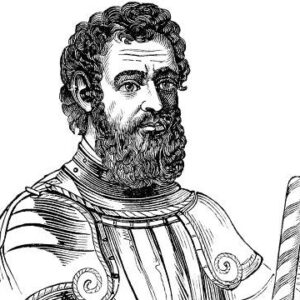While exploring the Atlantic coast of North America between Florida and New Brunswick, Giovanni da Verrazzano became the first European to sight New York and Narragansett Bay. Additionally, he is credited with the discovery of the Virginia and Delaware Capes, as well as New Jersey, Rhode Island, Massachusetts Bay, and the Maine Coast. He began his marine profession as a young man after being born in Florence, Italy. Curios and courageous, he traveled to areas such as Egypt and Syria that were not only difficult to reach but also regarded as mysterious and deadly for explorers. His adventurous nature eventually led him to France, where he was assigned to explore the East Coast of North America in search of a way to the Pacific by King Francis I. He discovered New York Harbor on his first expedition under French auspices while exploring the territory that would become North Carolina. Even though he was unable to find a path to the Pacific Ocean and Asia, his initial journey to the Americas significantly added to existing maritime knowledge. In 1528, he embarked on another expedition in search of a way to India, but his fleet became stranded in the Caribbean Sea. While sailing south of Jamaica, he abandoned his ship to investigate an uncharted island, where he was apprehended, slain, and devoured by cannibals.
Childhood & Adolescence
Giovanni da Verrazzano was born in 1485 in Val di Greve, south of Florence, the Republic of Florence’s capital and principal city at the time, to Piero Andrea di Bernardo da Verrazzano and Fiammetta Cappelli. He was, however, born in Lyon, France, as the son of Alessandro di Bartolommeo da Verrazano and Giovanna Guadagni, according to certain sources.
He received his education in Florence as a child. He was gifted in the classroom and excelled at maths.
He had a fascination with travel and adventure, and it is thought that during his early excursions, he sailed to Egypt and Syria.
Between 1506 and 1508, he relocated to France.
A Later Years
Around 1508, he joined a trip from Dieppe, France, to the coast of Newfoundland, Canada.
During this time period, European powers such as Spain and Portugal dispatched explorers like Christopher Columbus, Amerigo Vespucci, and Ferdinand Magellan to discover previously uncharted regions of the globe. Concerned that France was losing behind in the fields of exploration and colonization, King Francis I of France began preparing an expedition on his country’s behalf.
Verrazzano met the king between 1522 and 1523 and convinced him of his navigator ability, requesting to be assigned to France’s exploratory trips. He was tasked by the monarch with exploring the East Coast of North America in search of a path to the Pacific.
He planned the voyage meticulously, and within months, a fleet of four ships—Delfina, Normandy, Santa Maria, and Vittoria—sailed towards the Grand Banks of Newfoundland. Two of the ships, however, were lost in a fierce storm, forcing the other ships to return.
In late 1523, the expedition resumed its voyage. In January 1524, the ship Delfina finally set sail for the New World. Verrazzano, in search of a path to the Pacific Ocean and Asia, incorrectly stated to the king that the Pamlico Sound lagoon in contemporary North Carolina was the beginning of the Pacific Ocean, from which a passage to China might be reached.
He spent the following months exploring the areas surrounding Narragansett Bay, modern Maine, southeastern Nova Scotia, and Newfoundland. He also had extensive touch with the Native American tribes of the territories he traversed throughout the journey. Finally, in July 1524, he returned to France.
In 1527, he led a fleet of ships on a voyage to Brazil. Later that year, he returned home with a bountiful harvest of brazilwood.
Despite his numerous expeditions, Verrazzano had yet to discover the elusive Pacific Ocean passage. In 1528, he sailed on his second expedition to North America, determined to uncover this passage. Girolamo Verrazzano, Verrazzano’s brother, was also a member of this trip. Verrazzano’s expedition proved to be ill-fated, and he did not return alive.
His Significant Works
Giovanni da Verrazzano was a visionary explorer who was the first to declare that the land he encountered was not a part of Asia, but a New World. He never received the recognition he deserved, and many of his accomplishments went unnoticed. His own findings were eclipsed by the more spectacular Conquest of Mexico and Ferdinand Magellan’s journey of the globe that occurred around the same time period.
Personal History and Legacies
Little is known about this remarkable explorer’s personal life.
His fleet visited Florida, the Bahamas, and the Lesser Antilles during his third voyage to North America in 1528. The ships eventually wandered into the Caribbean, and while sailing south of Jamaica, the explorers came across a densely forested island.
Verrazzano and a few other men explored the island as the rest of the company waited aboard the ships. Verrazzano and his gang members were quickly assaulted and devoured by some cannibals. The men on board the ships looked on in horror but were powerless to assist their crewmates.
In Narragansett Bay, he is commemorated by the Jamestown Verrazzano Bridge and the Maryland Verrazzano Bridge.
Estimated Net worth
Unknown.


